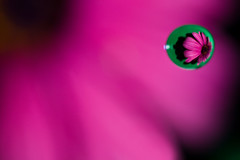I’ve been experimenting with water dripping from my kitchen sink lately, and doing a lot of reading about high speed photography. Even though I really don’t have the equipment to do it “the right way” I wanted to see what I could do, and maybe learn something more about flash photography. What I found out was not what I expected.
I’m going to tell you some things that might sound counter intuitive…
The goal was to take a photo of a water drop in front of a flower and the get the flower’s refraction in the drop. The setup is easy: Just punch a hole in a piece of heavy paper big enough to feed the stem of the flower through, and then tape the stem to the back of the paper. Set the paper in the sink behind the faucet and set the water to dripping rapidly to increase the chance that you’ll get a drop in the frame when you press the shutter release. Piece of cake, right?
All of my initial water drops suffered from motion blur…
I knew that the shutter speed was irrelevant, since it’s the burst of light coming from the flash that freezes the water in mid fall. I needed to make that burst as fast as possible using the 430EX that I have, and the only way I could come up with and still use E-TTL flash control was to open up the aperture and increase the ISO. But the intensity of the light, and the duration of the burst, is also dependant on the distance between the flash and the subject.
If you get the flash close to the subject the burst of light that it produces will be short.
For the image in this post I had the camera on manual mode F5.6, ISO 200, and 1/200 of a second –but ignore the shutter since the flash is freezing the action. Initially I was shooting at F8 and ISO 100 but the drops weren’t sharp enough. Notice that I changed the aperture and the ISO to vary the exposure –not the shutter. Also I had the flash about 10cm from the flower (around four inches) and I used an ST-E2 remote control to trigger it. You could use the built in flash on your camera, but glare is going to be a problem.
The “right way” to do this is to set up an infra red trigger so that the flash fires when the water drop breaks the infra red beam. But I don’t have the time to build, or money to buy one and I wanted to come up with a way that anybody could do. Have fun ;)
Footnote: You can also set your camera on a tripod and adjust the focus by placing a ruler under the dripping faucet (focus on the ruler with the water hitting it). Set an external flash (like the 430EX) to manual mode and set the power level to 1/16 to start. Set the camera to manual mode F5.6, ISO 200, and the shutter to 2 seconds. Press the shutter release and then, while pointing the flash at the subject, press the pilot lamp button to trigger the flash. Experiment with different power levels and the distance between the flash and the subject. You may also want to decrease the shutter speed just to cut down on long exposure noise.


4 comments:
Thank you thank you!
I need this kind of tech notes.
Not too techy but good clear guides.
Keep it up!
Thanks Joe! I do a lot of teaching and hopefully these posts are clear and easy to understand :)
Hi, one of success story of the blog
http://www.flickr.com/photos/sdgavali/sets/72157602128844960/
Cool -glad the tutorial helped you!!
Post a Comment